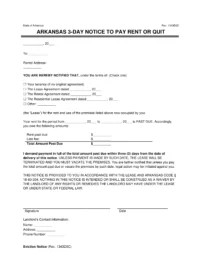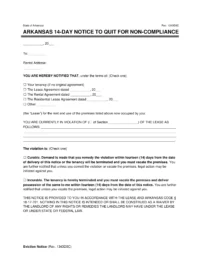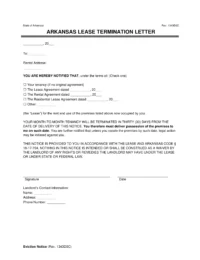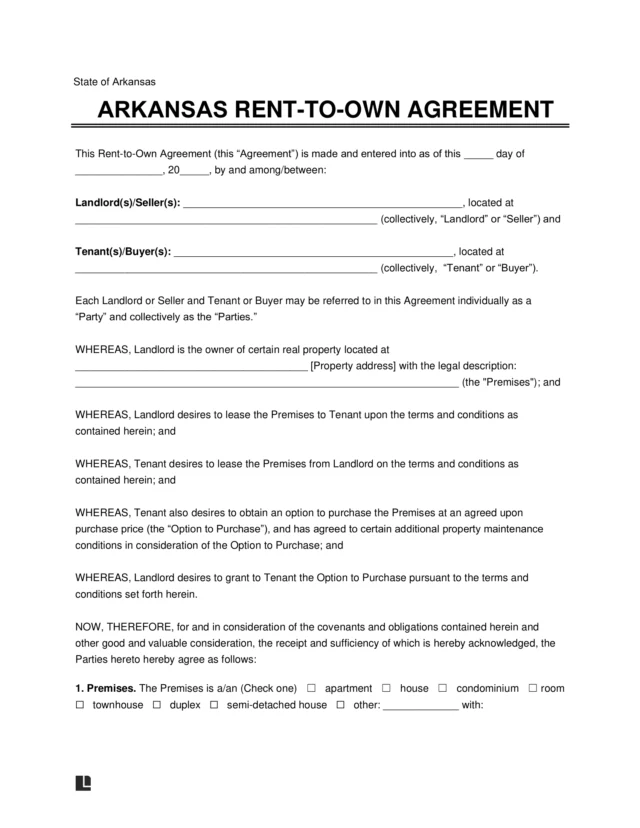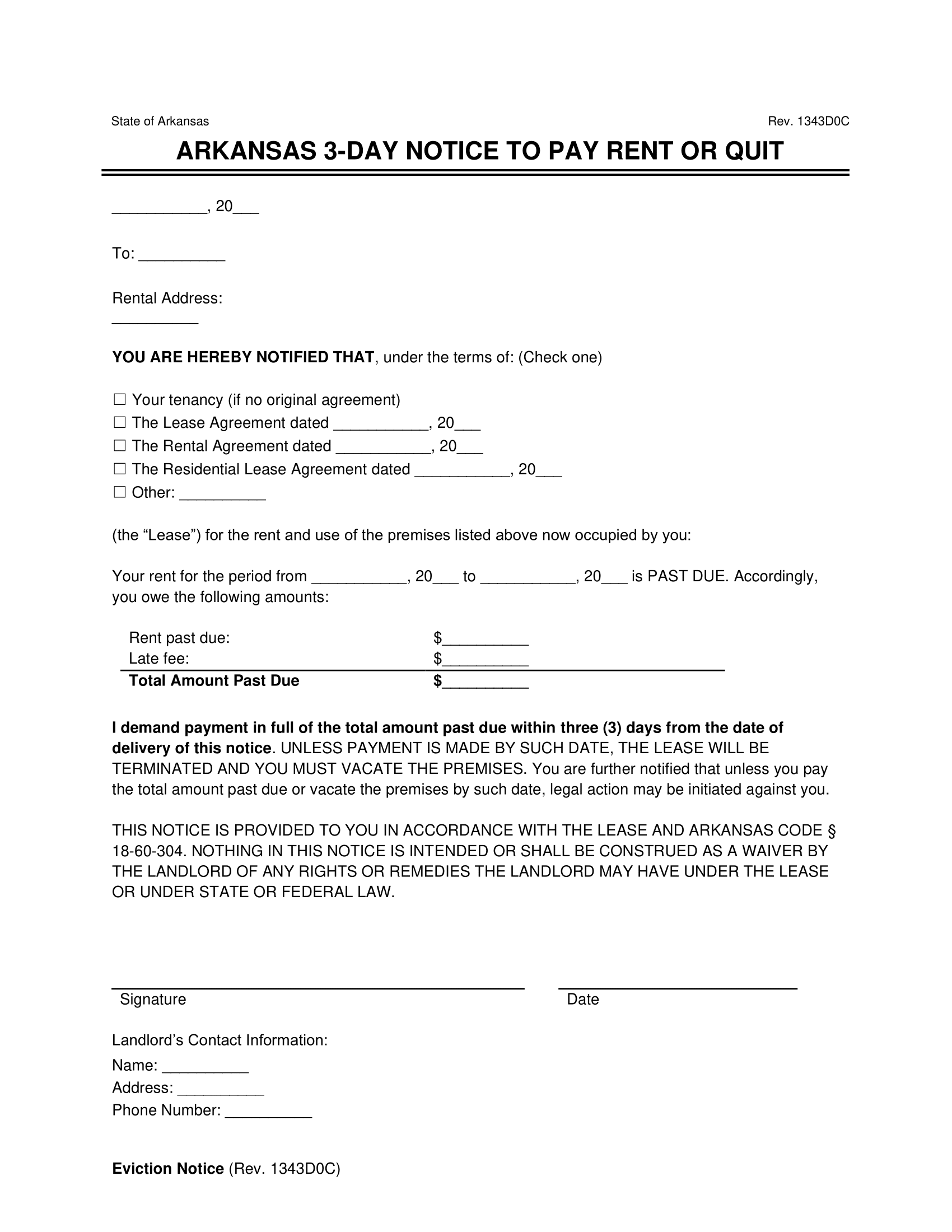Understanding Eviction Notices in Arkansas
Before a landlord in Arkansas can file an eviction lawsuit, they must first provide tenants with proper written notice. This notice must clearly state the reason for the eviction and give the tenant a legal window of time to either fix the issue or move out.
Our document builder helps Arkansas landlords create a compliant eviction notice tailored to their situation. Once completed, the form can be downloaded in Word or PDF format.
Types of Eviction Notices in Arkansas
Arkansas law outlines several types of eviction notices, each with its own required notice period depending on the lease violation or reason for ending the tenancy.
3-Day Notice to Pay Rent or Quit
Landlords may issue this notice when a tenant fails to pay rent. Under Arkansas Code Section 18-60-304(3), the tenant has 3 days to pay the overdue rent or vacate. Additionally, tenants in Arkansas are allowed a 5-day grace period after the rent due date before this notice can be issued (AR Code § 18-17-701(b)).
3-Day Notice to Pay Rent or Quit
Initiates the eviction process if the tenant hasn’t paid rent by the due date.
14-Day Notice to Quit for Lease Violation
When a tenant breaks a lease term, such as causing property damage or violating pet policies, landlords can serve a 14-day notice. AR Code § 18-17-701(a) gives the tenant 14 days to correct the issue or vacate the property.
14-Day Notice to Quit for Non-Compliance
Gives tenants who’ve broken the terms of a lease agreement 14 days’ notice before the eviction can proceed in court.
30-Day Notice to Terminate a Month-to-Month Tenancy
To end a month-to-month lease, Arkansas landlords are required to give tenants 30 days’ notice in writing, per AR Code § 18-17-704. This type of notice does not require a specific cause or lease violation.
30-Day Notice Lease Termination
Informs a tenant you’re ending a month-to-month lease agreement and they must vacate your property.
How to Evict a Tenant in Arkansas
Evictions in Arkansas must comply with the Residential Landlord-Tenant Act of 2007 (AR Code §§ 18-17-901–913) and the Unlawful Detainer procedures under AR Code §§ 18-17-901-913 and AR Code §§ 18-60-301-312.
Here’s how the eviction process works in Arkansas:
Step 1: Deliver Notice
The landlord must give the tenant the appropriate notice to begin the eviction (unlawful detainer) process.
Step 2: Wait for the Tenant to Act
If the tenant fixes (or “cures”) the problem or moves out within the required timeframe, then no further action is necessary.
Step 3: File Initial Court Documents
Suppose the tenant refutes the notice or fails to cure the breach(es). In that case, the landlord may file an unlawful detainer action in the Arkansas Circuit Court by paying a filing fee (currently $165) and submitting the following documents:
- Cover Sheet
- Summons
- Complaint
- Notice of intent to issue a Writ of Possession
Step 4: File Forms Before Hearing
Once the court receives the complaint and summons, the court will set a date for the hearing. The landlord must then serve legal documents to the tenant by mail (first class, certified mail, or registered mail), via personal delivery, or using a civil process server. This person will provide an affidavit of service for the landlord to file with the court.
Step 5: Tenant Answers the Complaint
After receipt of the summons, the tenant has 5 days to object in writing by filing an answer with the court. The court will decide if:
- The landlord or the tenant is correct at the hearing.
- There are any damages owed.
If the tenant doesn’t pay the owed rent or file an answer with the court, the court may issue a writ of possession, where the landlord will receive the property back and the tenant will be removed and barred from the premises.
Step 6: Follow Up on Other Damages
If there are other damages, including unpaid rent, cleaning, and court costs, a landlord may go after the tenant even after the tenant has been officially evicted.
Related Arkansas Court Forms
Here are some additional forms landlords and tenants in Arkansas should be aware of:
- Civil Action Cover Sheet: The landlord must file the Cover Sheet with the court along with the Summons and Complaint.
- Complaint: A document that the landlord files with the court and serves on the tenant that states the reason(s) for the eviction.
- Summons: The landlord files a Summons with the court, which is then served on the tenant to formally let them know a lawsuit has been filed against them. Once the tenant receives the forms, the server must complete the Affidavit or Proof of Service.
- Answer: The tenant (defendant) will be able to respond by filing an answer with the court.
- Writ of Possession: If the ruling favors the landlord, they can request this document from the court. A Writ of Possession is a court order that returns the legal possession of the property to the landlord and affirms that the tenant must leave the premises within twenty-four (24) hours or be forcibly removed by the county sheriff.

